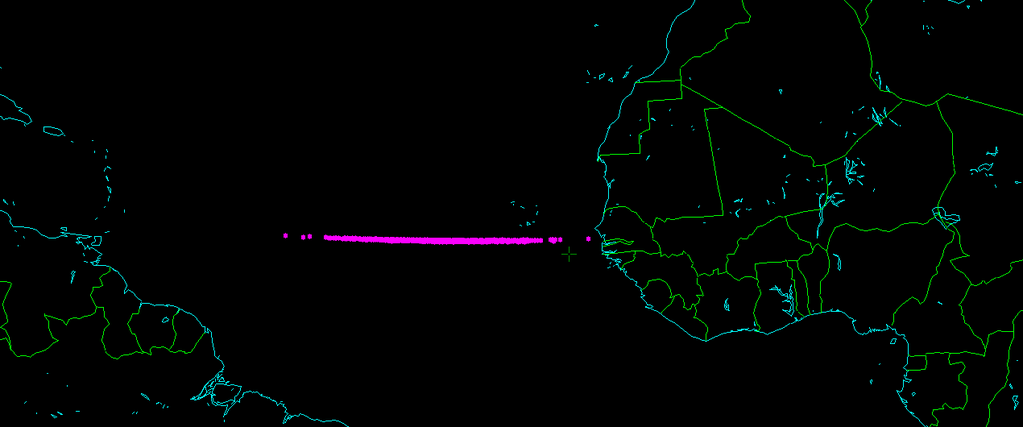Host: Fraser Cain
Guests: Emily Lakdawalla, David Dickinson, Jason Major, Brian Koberlein, Brian Wang
Continue reading “Weekly Space Hangout – January 3, 2014: Quadrantids & What’s Coming in 2014”
Ultra-Thin “Young” Crescent Moon Sighted from U.S. Southwest
Earlier this week, Universe Today challenged North American readers to spot the slender, exceptionally “young” crescent Moon on the evening of New Year’s Day.
Three visual athletes based in Arizona took up the challenge on Wednesday evening, with amazing results. Mike Weasner, Rob Sparks and Jim Cadien managed to spot the razor thin crescent Moon just 13 hours and 48 minutes after it passed New phase earlier on January 1st. The sighting was made using binoculars, and they even managed to image the wisp of a crescent hanging against the desert sky.
This is a difficult feat, even under the best of conditions. Weasner and Sparks observed from Mike’s Cassiopeia observatory based just outside of Oracle, Arizona.
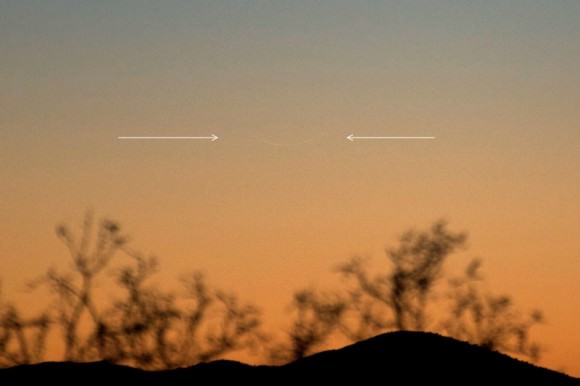
Concerning the feat, Weasner wrote on his observing blog:
“At 1800 Mountain Standard Time (MST), Rob reported that he had located the young Moon using his 8×42 binoculars. At 18:02 MST, I picked it up in the 12×70 binoculars. With the New Moon occurring at 11:14 Universal Time (UT), my observation occurred with the Moon only 13 hours and 48 minutes old. A new record for me (and Rob and Jim as well). Our DSLRs were clicking away!”
We can personally attest to just how hard it is to pick out the uber-thin crescent Moon against the twilight sky. Low contrast is your enemy, making it tough to spot and even tougher to photograph. Add to that a changing twilight sky that alters hue from moment to moment.
Though this isn’t a world record, its close to within about two hours. The youngest confirmed Moon spotting using binoculars stands at 11 hours and 40 minutes accomplished by Mohsen G. Mirsaeed in Iran back in September 7th, 2002, and the youngest Moon sighted with the unaided eye goes to Steven James O’Meara in May 1990, who spotted a 15 hour 32 minute old crescent.
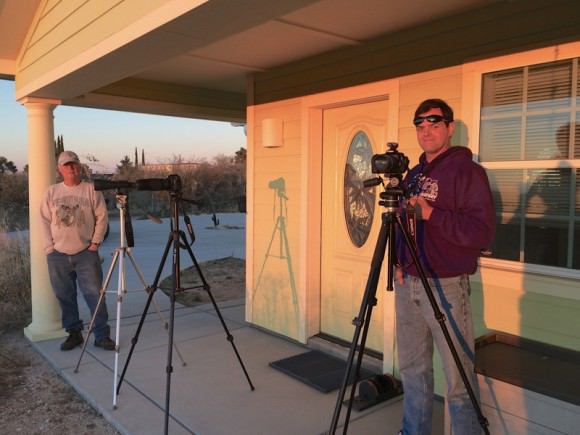
And of course, you can see the Moon at the moment of New during a a solar eclipse. Unfortunately, no total solar eclipses occur in 2014, just an usual non-central annular eclipse brushing Australia and Antarctica on April 29th and a deep 81% partial eclipse crossing North America on October 23rd.
Weasner also noted that a bright Venus aided them in their quest. It’s strange to think that Venus, though visually tiny, is actually intrinsically brighter than the limb of the Moon, owing to its higher albedo. In fact, some great pictures have also been pouring in to Universe Today of Venus as it heads towards inferior conjunction this month on January 11th. And don’t forget, that quoted magnitude of the lunar crescent (about magnitude -3.4) was also scattered along the lunar disk which was only 0.4% illuminated, and subject to atmospheric extinction to boot!
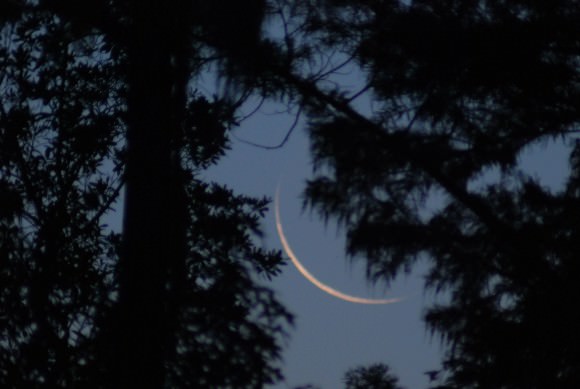
And yes, it is possible to catch the Moon photographically during a non-eclipse at the moment of New phase. The Moon can wander up to 5 degrees – about ten times its average apparent diameter as seen from the Earth – above or below the ecliptic and appear a corresponding distance from the limb of the Sun. Unlike many moons in the solar system, Earth’s moon has a fixed inclination to our orbit (as traced out by the ecliptic,) not our rotational axis. Thierry Legault accomplished this challenging photographic feat last year. Of course, this should only be attempted by seasoned astrophotographers, as aiming a camera near the Sun is not advised.
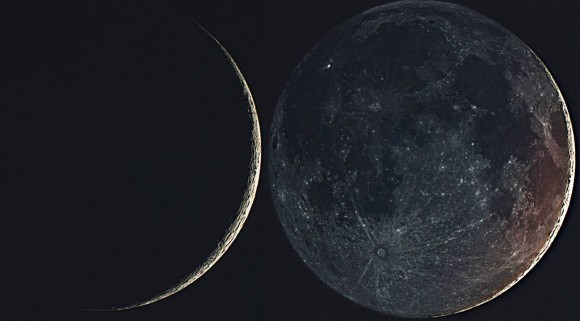
Why attempt to spot the razor thin New Moon? What’s the benefit? Well, several lunar based dating systems, such as the Islamic calendar, rely on the spotting of the new crescent Moon to mark the beginning of a new month. Being strictly lunar-based, the Islamic calendar moves an average of -11 days out of sync each year versus the modern day Gregorian calendar. On some years, there can even be a bit of ambiguity as to exactly when key months such as Ramadan will begin based on when the Moon is first sighted.
Also, such a feat demonstrates what the human eye is capable of when pushed to its physiological limits. In fact, French astrophysicist Andre Danjon theorized that the lunar crescent is formed at about 5 degrees elongation from the Sun, a point beyond which a lunar crescent can be sighted — usually quoted at about 7 degrees elongation from the Sun — and has become known as the Danjon Limit. Danjon also gave his namesake to the characterization of total lunar eclipses by color and hue, known as the Danjon Number. Accounting for the motion of the Moon, this places the theoretical limit that the forming crescent can be sighted with optical assistance at just over 11 hours.
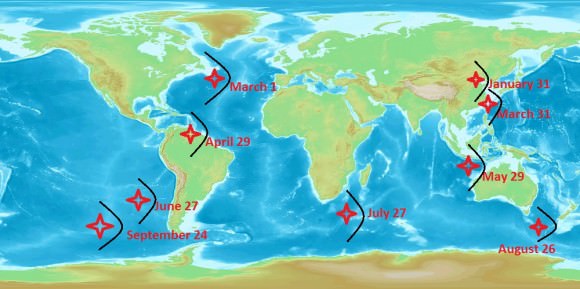
And you don’t have to wait until the Moon passes New… a similar attempt can be made in the dawn skies as the waning crescent Moon slides towards the Sun at the end of each lunation.
But perhaps the true reward is simply catching a glimpse of the ethereal for yourself, a delicate and airy Moon clinging briefly on the horizon. Kudos to Mike and Rob on a great catch!
Follow the further adventures of Mike Weasner and Rob Sparks on Twitter as @mweasner & @halfastro.
Wonder what the sighting opportunities are for the next waxing crescent Moon are worldwide? Two great online resources are the HM Nautical Office’s Einstein Moonwatch Project and Moonsighting.com.
The South African Astronomical Observatory also maintains a site with predictions worldwide.
Private American Rockets Blast Open 2014 & Commercial Space Race with Big Bangs on Jan. 6 & 7

Seaside panoramic view of an Antares rocket and Cygnus cargo spacecraft built by Orbital Sciences at Launch Pad 0A at NASA Wallops Flight Facility on the Virginia Eastern Shore. Blastoff for the ISS is slated for Jan. 7, 2014 at 1:55 p.m. EDT. Credit: Ken Kremer – kenkremer.com
UPDATE – Frigid Weather Delays Antares Launch to Jan. 8[/caption]
The status quo in space flight operations is no more.
Private American rockets are leading the charge of overdue change into the innovative ‘Commercial Space Race’ by blasting 2014 open with a pair of ‘Big Bang fireworks’ just a day apart on Jan. 6 and Jan. 7.
A dynamic duo of US aerospace firms – SpaceX and Orbital Sciences – are each poised to launch their own recently developed private boosters in the first week of the new year and aiming to dramatically cut costs.
And to top that off, the rockets are thundering aloft from two different spaceports located some 800 miles apart along the US East coast – weather permitting of course given the monster snow storm and frigid arctic air – akin to Mars – bearing down at this very moment on the big populations centers of the Atlantic coast region.
UPDATE ALERT – Antares Launch just postponed to Wed, Jan 8 at 1:32 p.m.due to extremely cold weather forecast. Back up day is Jan. 9
Both companies are revolutionizing access to space for both government entities as well as commercial companies doing lucrative business in space.
The implications of vastly reducing expenses for space travel and space commerce are far reaching and imperative – especially in the face of static and declining budgets mandated by politicians worldwide.
Except for China, which just landed its first rover on the Moon, is investing mightily in space and science and reaping strong economic growth.

SpaceX is first on deck with their next generation Falcon 9 rocket poised to soar on Monday, Jan. 6, with a highly valuable international payload – the Thiacom-6 commercial broadcasting satellite.
Note: This launch has just been postponed from Jan. 3 according to a brief statement I received from the USAF 45th Space Wing. Apparently due to concerns with the rocket – better safe than sorry.
Orbital Sciences follows up quickly on Tuesday, Jan. 7, with their two stage Antares rocket carrying the firm’s own Cygnus cargo vessel on its first operational commercial resupply mission for NASA – that’s bound for the International Space Station (ISS).
The upgraded SpaceX Falcon 9 v1.1 two stage rocket is slated to launch from complex 40 at Cape Canaveral Air Force Station, Florida, likely at dusk.
The original Jan. 3 Falcon 9 evening time launch had been scheduled for 5:50 p.m. Thaicom-6 will be placed into an elliptical supersynchronous transfer orbit.
The commercial space race sometimes makes for strange bedfellows. The Thaicom-6 satellite was built by Orbital Sciences.
This marks only the 2nd launch of the newly upgraded Falcon 9 from Florida. Read my eyewitness reports about the thunderous maiden liftoff barely a month ago on Dec. 3, 2013 with the SES-8 commercial telecom satellite – starting here.
The new Falcon 9 is the key to achieving SpaceX’s future launch manifest of some 50 payloads worth billions of dollars.
The next gen Falcon 9 will also launch the human rated SpaceX Dragon to the ISS. But first the Dragon and Falcon 9 must successfully achieve a pair of abort tests planned for 2014. Read my new article and discussion with SpaceX CEO Elon Musk – here.
The Jan. 7 Antares liftoff is currently scheduled for 1:55 p.m. EST from Launch Pad 0A at the Mid-Atlantic Regional Spaceport (MARS) at NASA Wallops Island, Virginia.
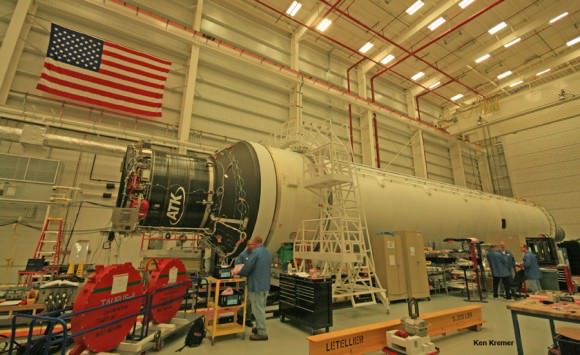
The Antares launch comes on the heels of the completely successful demonstration flight to the space station by Orbital Sciences in September 2013.
This flight was originally scheduled for mid-December 2013 in prime time but was postponed due to the urgent repairs required to get the ISS cooling system back in full operation.
And although it’s now moved to daylight by reason of orbital mechanics, the liftoff could still easily be visible to millions of residents along a wide swath of the US East Coast spanning from North Carolina to New York City – weather permitting.
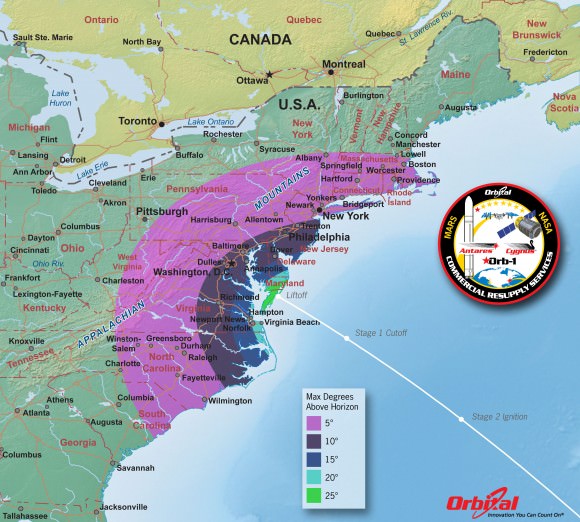
The Antares daytime launch will be visible to millions of spectators across a wide area of the Eastern US -weather permitting. This map shows the maximum elevation (degrees above the horizon) that the Antares rocket will reach during the Jan 7, 2014 launch depending on your location along the US east coast. Credit: Orbital Sciences
I’ll be covering the Antares launch, dubbed Orb-1, from on site at NASA Wallops – watch for my continuing reports.
The Cygnus logistics vessel will carry a total of 2,780 pounds of supplies to the station, including vital science experiments to expand the research capability of the Expedition 38 crew members aboard the orbiting laboratory, crew provisions, spare parts and experiment hardware, says NASA.
Also packed aboard the Antares/Cygnus flight are a batch of student experiments involving life sciences topics ranging from amoeba reproduction to calcium in the bones to salamanders.
“The 23 experiments flying next week [on Antares/Cygnus] are the culmination of 8,700 students engaged in real experiment design, and 1,800 proposals received by student teams,” Dr. Jeff Goldstein told Universe Today. Goldstein is the Center Director for the National Center for Earth and Space Science Education (NCESSE),which is sponsoring and organizing the student experiments.
This rocket volley is but the opening salvo of shots heard reverberating round the world that will surely “rock” the space industry to its core by cutting the steep cost of access to space.
“This is really rocking the industry. Everybody has to look out,” said Martin Halliwell, SES chief technical officer during a recent media briefing with Elon Musk, including Universe Today.
Both the SpaceX Falcon 9/Dragon and Orbital Sciences Antares/Cygnus vehicles were developed from the start with seed money from NASA in a public-private partnership.
The goal was to restore America’s cargo and crew capabilities to low Earth orbit and the ISS that was totally lost following the forced retirement of NASA’s Space Shuttles.
After a slow start, both Orbital Sciences and SpaceX have succeeded in bringing their new rockets and delivery vehicles safely on line.
SpaceX next Dragon cargo launch to the ISS is currently scheduled for Feb. 22, said SpaceX spokeswoman Emily Shanklin to Universe Today.
Stay tuned here for Ken’s continuing SpaceX, Orbital Sciences, commercial space, Chang’e-3, LADEE, Mars and more news.
…………….
Learn more about SpaceX, Orbital Sciences Antares Jan. 8 launch, Curiosity, Orion, MAVEN, MOM, Mars rovers and more at Ken’s upcoming presentations
Jan 7-9: “Antares/Cygnus ISS Rocket Launch from Virginia on Jan. 8” & “Space mission updates”; Rodeway Inn, Chincoteague, VA, evening
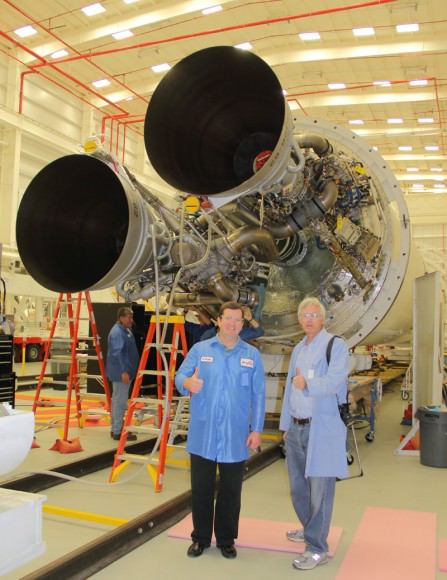
Gorgeous Astrophoto: Twin Crescents of the Moon and Venus at Sunset
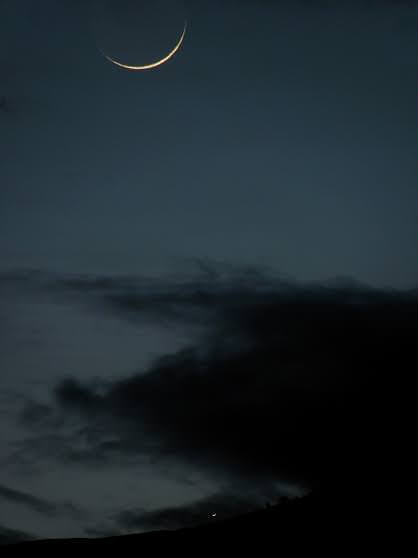
2014 starts out with sunset view of a new Moon and a fading look at Venus, both captured together in this gorgeous image from astrophotographer Giuseppe Petricca.
“A wonderful sunset conjunction this evening from Central Italy,” Giuseppe wrote via email. “The Moon and Venus were both crescent, in an awesome sight! Some clouds entered the scene, and helped me filter the bright light of the ‘evening star’, revealing the little arch of the planet, from our point of view.” He added that this is “the youngest Moon I’ve ever captured, about 2% lit.”
Below is an image with an inset of Venus enlarged for a better view:
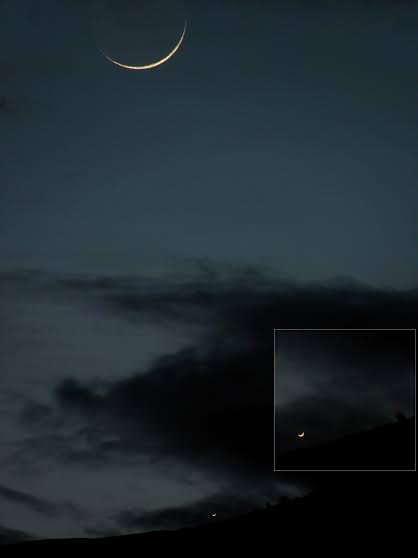
As our writer Bob King noted in his recent article, catch Venus now while you can, as it is slipping away: “As 2013 gives way to the new year, Venus winds up its evening presentation as it prepares to transition to the morning sky. Catch it while you can. Each passing night sees the planet dropping ever closer to the horizon as its apparent distance from the sun shrinks. On January 11 it will pass through inferior conjunction as it glides between Earth and Sun.”
Giuseppe’s images were taken with a simple non-reflex camera on a tripod, Nikon P90, ISO 100, f5.0, 1/2 exposure, which he says demonstrates “that with a little effort, you don’t need an expensive digicam to take this kind of shot.”
Beautiful!
Still Need a 2014 Calendar? Win “The Year in Space” Wall Calendar
If a 2014 calendar wasn’t in your holiday space stocking, here’s the perfect solution: this year’s edition of Steve Cariddi’s wonderful Year in Space Wall Calendar. It’s not too late to get your own copy, as 99% of 2014 is still remaining! Universe Today readers get a 24% to 41% discount and pay only $12.95 or less (using the current discount at this link), with free U.S. shipping and discounted international shipping.
But here’s your chance to win a copy! We’ve had two giveaways of this amazing calendar in the past month, but thanks to Steve, Universe Today now has an additional 5 copies to give away. To be entered into the drawing for our giveaway, just put your email address into the box below (where it says “Enter the Giveaway”) before Monday, January 6, 2014.
This calendar is full of amazing color images, daily space facts, historical references, and it even shows you where you can look in the sky for all the best astronomical sights. It also has in-depth info on human space flight, planetary exploration, and deep sky wonders. This calendar is huge — much larger than a traditional wall calendar — and is the perfect way to start the new year.
Find out more about the Year in Space calendar here, and our thanks again to Steve for providing this wonderful calendar for our readers.
If this is the first time you’re registering for a giveaway from Universe Today, you’ll receive a confirmation email immediately where you’ll need to click a link to be entered into the drawing. For those who have registered previously, you’ll receive an email later where you can enter this drawing.
Three-Meter Asteroid Hits Earth’s Atmosphere… Somewhere
This was very likely the last trip around the Sun for the Earth-crossing asteroid 2014 AA, according to calculations by several teams of astronomers and published online earlier today on the IAU’s Minor Planet Center. Discovered just yesterday by the Catalina Sky Survey, the estimated 3-meter-wide Apollo asteroid was supposed to clear Earth today by a razor-thin margin of about 611 km (380 miles)… but it’s now looking like it didn’t quite make it.
The diagram above, via Asteroid Initiatives’ Twitter feed, shows a projected path probability pattern for 2014 AA’s re-entry locations. No eyewitness accounts have yet been reported, and if anyone knows of any surveillance cameras aimed in those directions that might have captured footage of a bolide feel free to share that info below in the comments and/or with @AsteroidEnergy on Twitter.
Other calculations put the entry point anywhere between western Africa and Central America.
According to the MPEC report the asteroid “was unlikely to have survived atmospheric entry intact.”
Watch an animation below showing 2014 AA’s point-of-view as it met Earth. (Video courtesy of Pasquale Tricarico, senior scientist at the Planetary Science Institute in Tucson, AZ.)
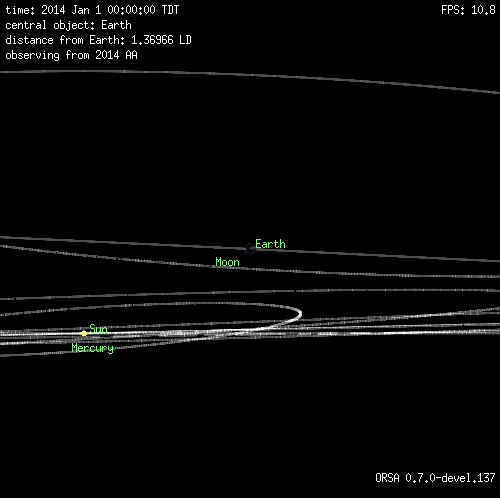
JPL’s Near-Earth Object program classifies Apollo asteroids as “Earth-crossing NEAs with semi-major axes larger than Earth’s (named after asteroid 1862 Apollo).” And while not an Earth-shattering event (fortunately!) this is just another small reminder of why we need to keep watch on the sometimes-occupied path our planet takes around the Sun!
Read the NASA/JPL news release on 2014 AA here.
h/t to Dr. John Barentine for the heads-up!
UPDATE: Based on infrasound analysis by Peter Brown of the University of Western Ontario, 2014 AA likely impacted the atmosphere over the Atlantic around 0300 UTC at 40° west, 12° north — about 1,900 miles east of Caracas, Venezuela. The impact released the equivalent of 500 to 1,000 tons (0.5 – 1 kiloton) of TNT, but far above a remote and uninhabited area. Read more on Sky & Telescope here.
Comets Prospects for 2014: A Look Into the Crystal Ball

As 2014 opens, most of the half dozen comets traversing the morning and evening sky are faint and require detailed charts and a good-sized telescope to see and appreciate. Except for Comet Lovejoy. This gift to beginner and amateur astronomers alike keeps on giving. But wait, there’s more. Three additional binocular-bright comets will keep us busy starting this spring.
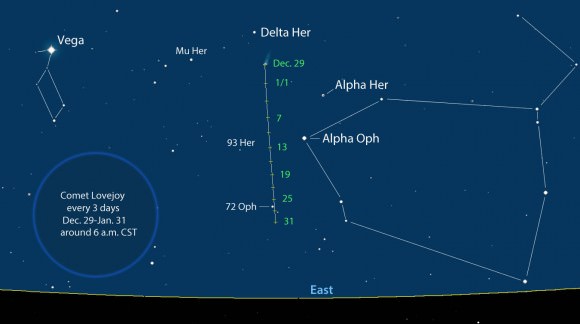
Still glowing around the naked eye limit at magnitude 6, the Lovejoy remains easy to see in binoculars from dark skies as it tracks from southern Hercules into Ophiuchus in the coming weeks.
The best time to view the comet is shortly before the start of dawn when it sails highest in the eastern sky at an altitude of around 30 degrees or “three fists” up from the horizon. By January’s end, the comet will still be 25 degrees high in a dark sky. My last encounter with Lovejoy was a week ago when 10×50 binoculars revealed a bright coma and 1.5 degree long tail to the northwest. Through the telescope the stark contrast between bright, compact nucleus and gauzy coma struck me as one of the most beautiful sights I’d seen all month.
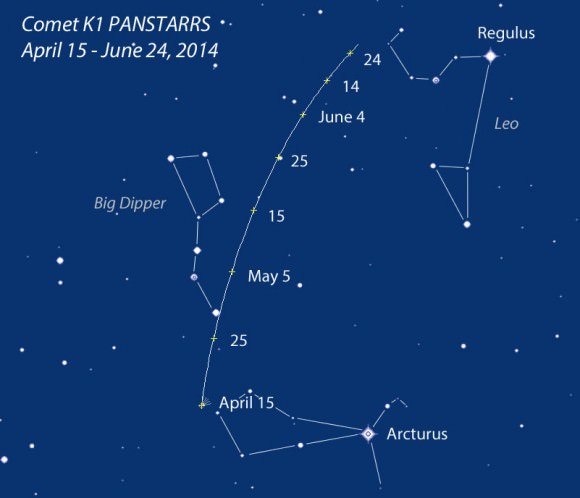
Looking ahead to 2014 there are at present three comets beside Lovejoy that are expected to wax bright enough to see in binoculars and possibly with the naked eye: C/2012 K1 PanSTARRS, C/2013 V5 Oukaimeden and C/2013 A1 Siding Spring The first lurks in Hercules but come early April should bulk up to magnitude 9.5, bright enough to track in a small telescope for northern hemisphere observers. Watch K1 PANSTARRS amble from Bootes across the Big Dipper and down through Leo from mid-spring through late June hitting magnitude 7.5 before disappearing in the summer twilight glow. K1 will be your go-to comet during convenient viewing hours.
Come early September after K1 PANSTARRS leaves the sun’s ken, it reappears in the morning sky, traveling westward from Hydra into Puppis. Southern hemisphere observers are now favored, but northerners won’t suffer too badly. The comet is expected to crest to magnitude 5.5 in mid-October just before it dips too far south for easy viewing at mid-northern latitudes.
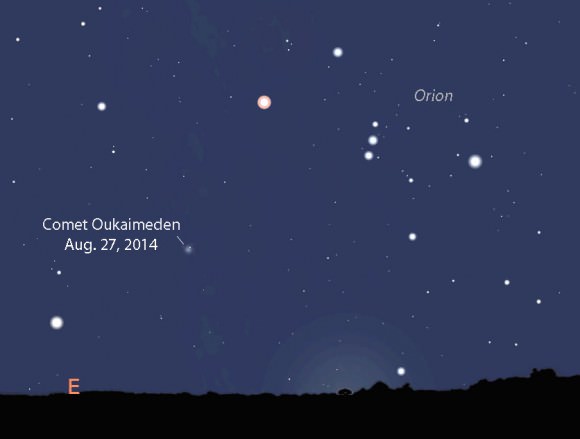
Comet C/2013 V5 (Oukaimeden), discovered November 15 at Oukaimeden Observatory in Marrekesh, Morocco. Preliminary estimates place the comet at around magnitude 5.5 in mid-September. It should reach binocular visibility in late August in Monoceros the Unicorn east of Orion in the pre-dawn sky before disappearing in the twilight glow for mid-northern latitude observers. Southern hemisphere skywatchers will see the comet at its best and brightest before dawn in early September and at dusk later that month.
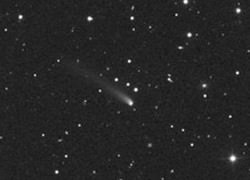
2014’s most anticipated comet has to be C/2013 A1 Siding Spring, expected to reach magnitude 7.5 and become binocular-worthy for southern hemisphere skywatchers as it traverses the southern circumpolar constellations this September. Northerners will have to wait until early October for the comet to climb into the evening sky by way of Scorpius and Sagittarius. Watch for an 8th magnitude hazy glow in the southwestern sky at that time.
As October ticks by, A1 Siding Spring creeps closer and closer to Mars until it overlaps the planet on the 19th. Normally, a comet will only appear to pass in front of stars and deep sky objects because it’s in the same line of sight. Not this time. Siding Spring may actually “touch” Mars for real.
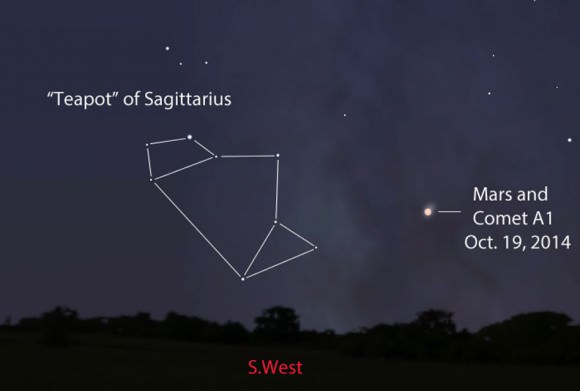
On October 19 the comet will pass so close to the planet that its outer coma or atmosphere may envelop Mars and spark a meteor shower. The sight of a bright planet smack in the middle of a comet’s head should be something quite wonderful to see through a telescope.
While the list of predicted comets is skimpy and arguably not bright in the sense of headliners like Hale-Bopp in 1997 or even L4 PANSTARRS from last spring, all should be visible in binoculars from a dark sky site.
Every year new comets are discovered, some of which can swiftly brighten and put on a great show like Comet Lovejoy (discovered Sept. 7) did last fall and continues to do. In 2013, 64 new comets were found, 14 of them by amateur astronomers. Comets with the potential to make us ooh and aah are out there – we just have to find them.
Astrophoto: Crescent Venus in the Afternoon
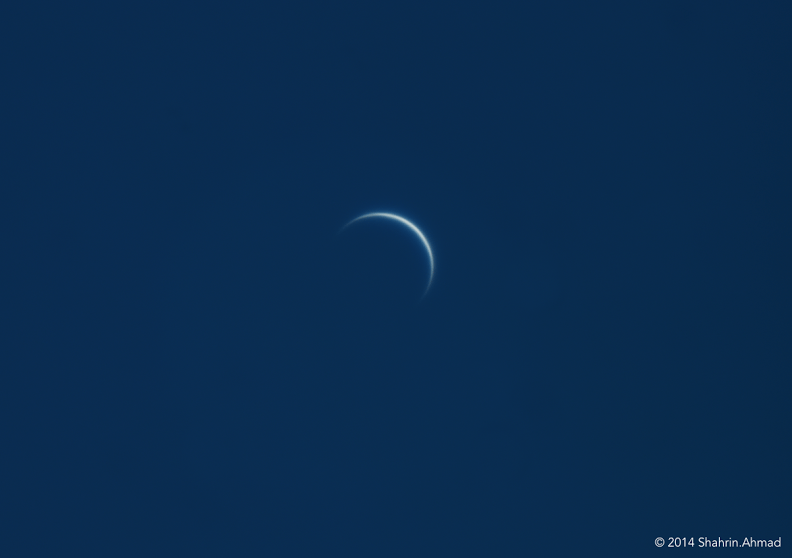
In December, we challenged our readers to try and see Venus during the daytime. Sharin Ahmad from Kuala Lumpur, Malaysia started off the new year by nailing this awesome picture of a crescent Venus at just after noon local time today (January 2, 2014). “The usual cloudy Kuala Lumpur sky is teasing me again, giving me crystal blue sky today!” Shahrin said via email.
Based on SkySafari, Venus was about 3.2% illuminated, and about 15 degrees from Sun.
Equipment: Skywatcher 120ED (F=1800mm), and IMG132E video camera.
Here are other recent images of Venus submitted to our Flickr page by our readers:
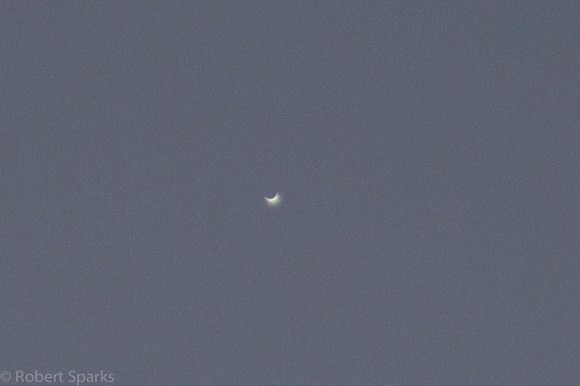

Want to get your astrophoto featured on Universe Today? Join our Flickr group or send us your images by email (this means you’re giving us permission to post them). Please explain what’s in the picture, when you took it, the equipment you used, etc.
Carnival of Space #334
This week’s Carnival of Space is hosted by Allen Versfeld at his Urban Astronomer blog.
Click here to read Carnival of Space #334.
And if you’re interested in looking back, here’s an archive to all the past Carnivals of Space. If you’ve got a space-related blog, you should really join the carnival. Just email an entry to [email protected], and the next host will link to it. It will help get awareness out there about your writing, help you meet others in the space community – and community is what blogging is all about. And if you really want to help out, sign up to be a host. Send an email to the above address.
Happy New Year’s Day 2014 from Mars – Curiosity Celebrates 500 Sols Spying Towering Mount Sharp Destination

Curiosity Celebrates 500 Sols on Mars on Jan. 1, 2014
NASA’s Curiosity rover snaps fabulous new mosaic spying towering Mount Sharp destination looming dead ahead with her high resolution color cameras, in this cropped view. See full mosaic below. Imagery assembled from Mastcam raw images taken on Dec. 26, 2013 (Sol 494).
Credit: NASA/JPL/MSSS/Marco Di Lorenzo/Ken Kremer- kenkremer.com
Story updated[/caption]
Today, New Year’s Day 2014, NASA’s Curiosity mega rover celebrates a huge mission milestone – her 500th Martian Day on the Red Planet since the death defying touchdown of August 2012.
“500 Sols of Mars: While Earth celebrates #NewYear2014, midnight on Mars mark my 500th day of operations,” she tweeted today.
And Curiosity marked the grand occasion by snapping a fabulous new panorama spying towering Mount Sharp – looming dead ahead in her high resolution color cameras.
You can take in the magnificent Martian view Curiosity sees today – via our newly assembled mosaic of humongous Mount Sharp rising 5.5 kilometers (3.4 mi) into the Red Planets sky; see above and below.
Ascending mysterious Mount Sharp – which dominates the Gale Crater landing site – is the ultimate reason for Curiosity’s being.
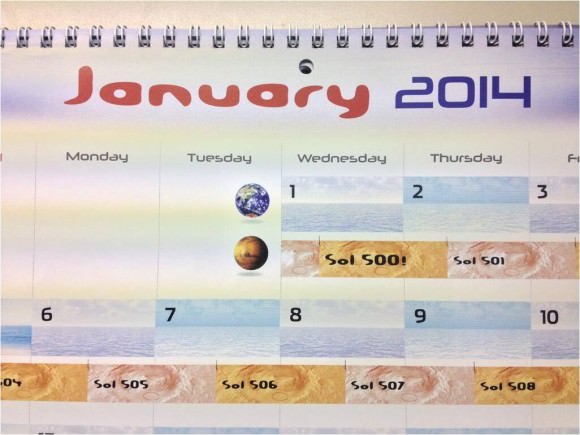
NASA’s science and engineering teams dispatched the state-of-the-art robot there because they believe the lower sedimentary layers hold the clues to the time period when Mars was habitable eons ago and they possess the required chemical ingredients necessary to sustain microbial life.
But first she needs to reach the mountains foothills.
So, just like some Earthlings, Curiosity also set a New Year’s resolution she’d like to share with you all – just tweeted all the way from the Red Planet.
“Goals for 2014: Finish driving to Mars’ Mount Sharp & do all the science I can.”

Part of those goals involve shifting the missions focus to include the search for organic molecules – the building blocks of life as we know it – which may be preserved in the sedimentary rock layers.
“Really what we’re doing is turning the corner from a mission that is dedicated to the search for habitable environments to a mission that is now dedicated to the search for that subset of habitable environments which also preserves organic carbon,” Curiosity Principal Investigator John Grotzinger, of the California Institute of Technology in Pasadena, said recently at the Dec. 2013 annual meeting of the American Geophysical Union (AGU).
The 1 ton behemoth is in the midst of an epic trek to destination Mount Sharp, roving across 10 kilometers (6 mi.) of the rather rocky crater floor of her landing site inside Gale Crater.
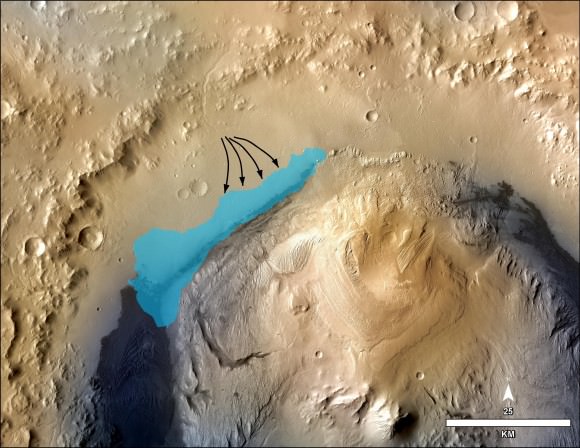
But the alien crater floor strewn with a plethora of sharp edged rocks is ripping significant sized holes and causing numerous dents in several of the rovers six big aluminum wheels – as outlined in my prior report; here.
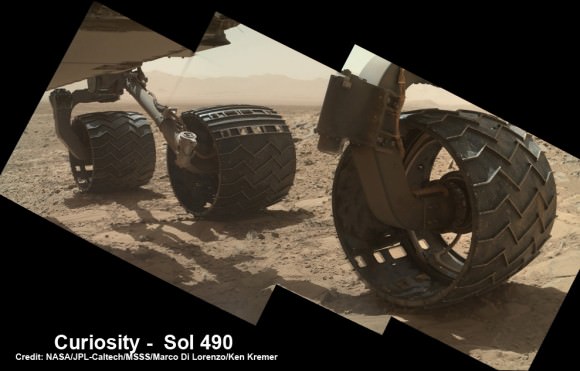
“Routes to future destinations for the mission may be charted to lessen the amount of travel over such rough terrain, compared to smoother ground nearby,” says NASA.
So far Curiosity’s odometer stands at 4.6 kilometers, following a post Christmas drive on Dec. 26, 2013 (Sol 494) after 16 months roving the Red Planet.
Curiosity’s handlers will be diligently watching the wear and tear on the 20 inch diameter wheels. She needs to rove along a smoother path forward to minimize wheel damage by sharp rocks.
Here’s our latest wheel mosaic from Dec. 26, 2013 (Sol 494) showing a several centimeter wide puncture in the left front wheel, which seems to have suffered the most damage.
The Mount Sharp and wheel mosaics were assembled by the imaging team of Marco Di Lorenzo and Ken Kremer.
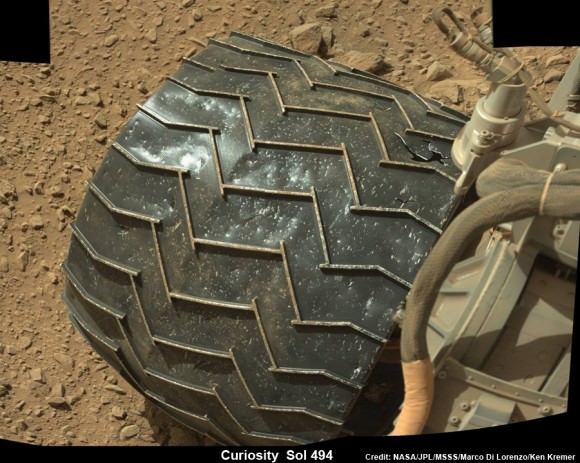
“Taking stock this holiday season. I’m planning smoother paths for the new year,” Curiosity tweeted.
The team hopes the intrepid robot arrives at the base of Mount Sharp around the middle of this new year 2014, if all goes well.
Shortly thereafter the robot begins a new phase with the dramatic ascent up the chosen entryway which the team dubs the ‘Murray Buttes’ – fittingly named in honor of Bruce Murray, a Caltech planetary geologist, who worked on science teams of NASA’s earliest missions to Mars in the 1960s and ’70s.
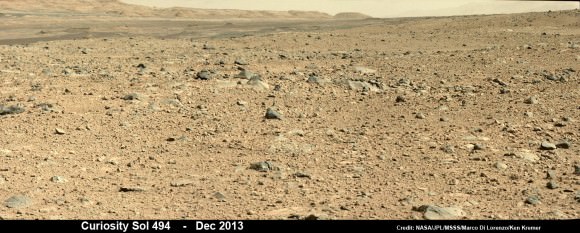
Murray also was the director of NASA’s Jet Propulsion Laboratory from 1976 to 1982 and co-founded the Planetary Society in 1980. He passed away on Aug. 29, 2013.
“Bruce Murray contributed both scientific insight and leadership that laid the groundwork for interplanetary missions such as robotic missions to Mars, including the Mars rovers, part of America’s inspirational accomplishments. It is fitting that the rover teams have chosen his name for significant landmarks on their expeditions,” said NASA Mars Exploration Program Manager Fuk Li, of NASA’s Jet Propulsion Laboratory (JPL) , Pasadena, Calif.
Curiosity has already accomplished her primary goal of discovering a habitable zone on Mars that could support Martian microbes if they ever existed.
NASA’s rover Curiosity uncovered evidence that an ancient Martian lake had the right chemical ingredients, including clay minerals that could have sustained microbial life forms for long periods of time – and that these habitable conditions persisted on the Red Planet until a more recent epoch than previously thought.
Meanwhile, NASA’s Opportunity rover is ascending Solander Point on the opposite side of Mars.
And a pair of newly launched orbiters are streaking to the Red Planet; NASA’s MAVEN and India’s MOM.
And China’s new Yutu lunar rover and Chang’e-3 lander are napping through the lunar night.
For a great compilation of the top space events in 2013- read this article.
Stay tuned here for Ken’s continuing Curiosity, Chang’e-3, SpaceX, Orbital Sciences, LADEE, MAVEN, Mars rover and MOM news.
…………….
Learn more about Curiosity, MAVEN, MOM, Mars rovers, SpaceX, Orbital Sciences Antares Jan. 7 launch, and more at Ken’s upcoming presentations
Jan 6-8: “Antares/Cygnus ISS Rocket Launch from Virginia on Jan. 7” & “Space mission updates”; Rodeway Inn, Chincoteague, VA, evening




